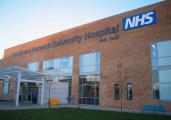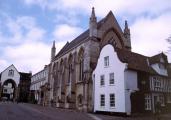The training programme is based at the Norfolk & Norwich University Hospital (NNUH) and nearby East of England Imaging Academy. The academy was set up in 2005 and aims to train radiologists through a mixture of clinical experience, tutorials, simulators and use of archived investigations.
The scheme offers subspecialty training in Cardiothoracic, Gastrointestinal, Gynae/Urogenital, Musculoskeletal, Breast, Nuclear Medicine, Head & Neck, and Oncology. The Academy also offers ST4-ST6 subspecialty training in Interventional Radiology, to which trainees are appointed by competitive recruitment in their ST3 year. We also support trainees in finding subspecialty training placements in Paediatric Radiology and Neuroradiology, both within the region and beyond.
There are plenty of opportunities to get involved in teaching, audit and research at NNUH. In addition there is funding for an academic clinical fellowship post for trainees who are keen on research.
Norwich is the capital of a wonderful rural county with some great beaches, picturesque towns and villages, and the natural beauty of the Norfolk Broads – Britain’s largest protected wetland and the third largest inland waterway.
Norwich leads The Guardian’s 10 Happiest Cities to Work in the UK, is in the Telegraph’s Britain’s 20 Best Cities and North Norfolk is number two in Britain’s Top 20 places to raise a family. It is an easy drive or train journey to the counties of Suffolk and Cambridgeshire and has direct trains to London Liverpool Street.
It is home to the University of East Anglia, Norwich University College of the Arts and many good schools. It has a vibrant nightlife, based around the regenerated Riverside area of the city centre and is also popular for arts, culture, music, and tourism. The city has 25 parks, gardens and recreation grounds to choose from, as well as cinemas, theatres and other attractions.
The Norfolk and Norwich University Hospital is a 1,200 bed teaching hospital. It provides a full range of services to the population of Norfolk and Norwich including oncology, trauma and orthopaedics, paediatrics, plastic surgery, vascular surgery and interventional radiology. There are close links with the University of East Anglia which trains doctors, nurses, midwives and a full range of other allied health professionals and also undertakes clinical research. There are currently 36 radiology consultants and over 50 radiology registrars.
Core Training
YEAR 1-3
The initial six months are based mainly at the academy, during which time the trainees receive intensive teaching which includes focused physics and anatomy teaching for the Part 1 FRCR exam, ultrasound teaching and practice, teaching on plain film reporting. They are also introduced to most radiology subspecialties, including four weeks in the NNUH Radiology department experiencing how the different imaging modalities are used in clinical practice.
Four months of the ST1 year are spent at a District General Hospital (DGH) in the region, focusing on learning the fundamentals of general ultrasound, plain film reporting and inpatient CT reporting. We offer up to 12 different DGH options, ranging from King’s Lynn in the north to Romford in the south, and aim to be as flexible as we can in accommodating trainees’ placement requests.
During the rest of the ST1-ST3 years, trainees will undertake nine three-month core modules based at NNUH (though some modules can be undertaken elsewhere if the trainee desires). These cover neuroradiology, cardiorespiratory, gastrointestinal, gynae/urogenital, musculoskeletal, paediatrics, breast and Nuclear Medicine imaging.
Higher Specialist Training
YEAR 4 and 5
The aim of the ST4 year is for trainees to consolidate their general radiology knowledge and skills, become competent in US/CT-guided biopsies and drainages, gain some leadership and management experience, and to explore subspecialty interests. This is achieved through a senior six-month DGH attachment and a six-month higher subspecialty training block at NNUH. Many of the DGH departments have sub-specialist interests which trainees will select to meet their training needs. During their higher subspecialty training block, trainees take on the role of 'Lead Registrar' and will represent the trainee body in departmental meetings. The Lead Registrar is also responsible for organising the weekly registrar rota.
There is a 24 hour on-call service for general radiological emergencies with first on-call cover provided by registrars backed up by a consultant on-call. There is one registrar on-call during weekday evenings (5-8pm), one registrar on-call overnight (8pm-8am) and two registrars on-call during the daytime on both Saturdays and Sundays. All CT scans reported by the on-call registrars are checked by the consultant on-call, either on the same day (for scans done during the day) or the following morning (for scans done overnight), and any useful feedback is provided to the registrars. A separate Interventional Radiology on call rota is provided by consultants and senior IR trainees.
Trainees typically start on-calls towards the end of their ST2 year, having done plenty of supervised inpatient CT/MRI reporting, having passed assessments in plain film reporting and general ultrasound, and after participating in the local on-call preparation course and passing a pre-on call CT test. Due to the large number of registrars on the on-call rota (currently well over twenty), the frequency of on-call shifts is lower than most other training programmes.
After the initial six months of intensive teaching at the academy, the following two and half years of training are supported by a structured teaching programme every Thursday afternoon which takes place at the Academy and helps to prepare trainees for the FRCR Part 2a and 2b examinations. In addition there are regular, timetabled consultant tutorials several times each week, most of which take place in the hospital, as well as an FRCR 2b course run at the Academy for trainees about to take their Part 2b exam. There is also a monthly teaching programme for senior trainees who have passed their fellowship exams which focuses more on non-clinical aspects, in preparation for becoming a consultant.
Email: eoe.imagingacademy@nnuh.nhs.uk
Phone: 01603 286 140
For further information please see our website: www.imagingacademy-eoe.co.uk/
 Follow us on Twitter
Follow us on Twitter
@eoe_imagingacad
Follow us on Instagram
@eoeimagingacademy
Below are some examples of courses regularly run at the acadmey. For further information on any of these, including upcoming dates, please see our website: www.imagingacademy-eoe.co.uk/
Image Guided Intervention for Beginners
Course overview: This course aims to teach and reinforce the basics of the
tools used and skills needed in interventional radiology. It is aimed at ST1-3 trainees in radiology who wish to develop their skills in performing basic
procedures and for those who wish to apply for training in interventional
radiology.
Aim: To teach and reinforce the basics of the tools used and skills needed in
interventional radiology
We utilize a state of the art Mentice simulator (VIST-LAB with VIST G5) and
different physical models. In addition, there is an industry supported
Symbionics EVAR simulator.
Objectives:
• To provide insight into a standard IR case by observing a live procedure
via video link
• Know the steps involved in performing endovascular procedures using a simulator
• Know how to perform US guided procedures using phantoms
• Know the tools and kit used in IR and image guided procedures
• Know how to tailor your CV to get into interventional radiology
Advanced Endovascular Workshop
Course overview: This brings together experts in aortic and peripheral vascular
interventions. The course aims to teach and reinforce the principles of planning and performing aortic and peripheral vascular interventions. It is aimed at IR and vascular surgical trainees who have a basic understanding of vascular interventions and who wish to develop their skills in planning and performing standard EVAR and complex peripheral vascular interventions. The course combines lectures with extensive opportunity for hands on practise with simulators. We utilize a state of the art Mentice simulator (VIST-LAB with VIST G5) and different physical models. In addition, there will be an industry supported Symbionics EVAR simulator.
Aim: To teach and reinforce the principles of planning and performing aortic and peripheral vascular interventions
Objectives:
• To provide insight into a complex peripheral vascular case by observing a live procedure via video link
• Know and demonstrate the steps involved in performing endovascular
procedures using a simulator (angioplasty, stenting and EVAR) & how to deal with complications
• Know how to interpret CT angiograms and its use in EVAR case planning
• Know the tools and kit used in endovascular procedures
• Learn 'tips and tricks' on how to deal with difficult cases
Paediatric Intussusception Reduction Simulator Training for Radiology Trainees
This course is done as part of training for the radiology trainees before they start on call. The simulator is made of a doll, a laptop containing software, insufflation device and a manometer. The course aims to provide them with a basic knowledge of intussusception reduction. we do a lot of scenario based learning and do role play to enhance the importance of consenting alongside learning the procedure. The course is run once a year for the trainees at the radiology academy. We aim to make this course available to all deanery trainees for educational benefits.
Intelligent Ultrasound Scan Trainer
The simulator provides education, training and practice not only for trainees, but also for Emergency Medicine/A&E doctors to practice skills, without effect on patient morbidity or mortality. The simulator has been in place at the Academy since January 2016 and has been used by a variety of staff including Radiology trainees, Sonographers, Obstetrics and Gynaecological trainees and midwives. The plan is to incorporate assessment on the simulator with clinical placement assessment for Radiology trainees. This method has been successfully incorporated into many Sonographer courses.




